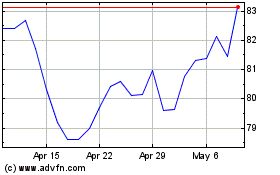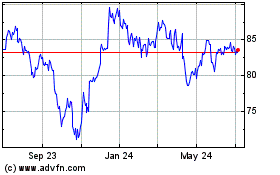2 Rate Sensitive Sector ETFs on Fed's Latest Move - ETF News And Commentary
March 21 2014 - 10:00AM
Zacks
As widely expected, the
Federal Reserve announced further trimming of $10 more billion in
its monthly long-term bond purchases. The latest cut takes the
Fed’s monthly asset repurchase program to $55 billion a month.
While this was not surprising on the Taper front, the main twist
came in the interest rate guidance.
The Fed had so far vowed to keep the short-term rate near zero
level. But the chairwoman Janet Yellen said during her press
conference that the Fed could start raising interest rates six
months after it fully wraps up its bond buying program this fall.
Notably, the Fed's benchmark short-term rate has been at the
rock-bottom level since 2008.
Following this statement, some economists perceived the time frame
of rate rise as mid 2015. Futures traders brought forward their
anticipated timing of first interest rate hike to April 2015 from
the previous expectation of July. However, there is a
different view as well. According to a Reuters poll, most renowned
Wall Street economists continue to see the first rate hike to hit
the economy in the second half of 2016.
Whatever be the time frame, the market started to panic on Fed’s
comment on rate hike with both bond and equities markets slipping
in the key trading session and dollar gaining strength. Previously,
it has been noticed that each measured tapering announcement renews
concerns of rising rates. This time, alteration in Fed’s interest
rate guidance has added to the woes.
Short-term U.S. bond yields spiked the highest in almost three
years after Yellen’s comments, with the 10-year Treasury yield
jumping 373 basis points to 2.78% (as of March 19, 2014). The rates
are expected to move northward in the comings months thanks to
acceleration in QE tapering.
Amid such a backdrop, it will be prudent to note the performance of
two rate-sensitive sectors to gauge investors’ sentiment regarding
the economy’s next move. Apparently, these two sector ETFs might be
in trouble in the near term (read: Real Estate ETFs in Focus as
Rates Turn Higher).
REIT
REIT is highly interest rate sensitive sector. This is especially
true in a high volatility corner of the market known as the
mortgage REIT or mREIT space. mREITs generally use a short-term
loan to purchase long-term securities and generate revenues from
the spread between the two. Therefore, to make profits, these firms
need a wide spread between the short and long-term rates.
These firms are usually highly leveraged and face maximum interest
rate risk in the REIT world. This can clearly explains why this
sector will underperform if short-term interest rate makes an
ascent. Now, REITs are required to distribute 90% of their annual
taxable income through dividends which make them high dividend
yield vehicles. With the declining income of REITs due to the
impact of rising interest rates, the dividend yield will also fall
along with returns.
This is why the largest REIT ETF Vanguard REIT Index ETF (VNQ) fell
1.89% following the Fed’s comment in contrast to a 0.53% decline in
broader market ETF SPDR S&P 500 (SPY). The biggest iShares
Mortgage Real Estate Capped ETF (REM) was down
1.55% at the close of March 19 (read: REIT ETFs in Taper Aftermath:
Any Hope for Gains Now?).
Utilities
Being a highly safe sector, utilities started the year on a strong
footing. While operating metrics remain in place, the sector might
suffer in the coming days on its increased dependence on interest
rate policy. The sector requires huge infrastructure which places a
massive debt burden and the resultant interest obligation on these
companies. This leaves the sector with no scope of outperformance
in a rising rate environment (read: The Comprehensive Guide to
Utility ETFs).
Also, investors look for dividend as a high yield tool. With bond
yields preparing to take an upturn, utilities will likely lose its
high-yield charm. The biggest utility ETF
Utilities Select Sector SPDR ETF (XLU) lost about
1.58% at the close of March 19.
Bottom Line
The cloud over the trimming of the Fed’s bond buying policy is
dispersing gradually. With the current unemployment level of 6.7%
slowing reaching the Fed’s threshold limit of 6.5%, we expect the
Fed to maintain the regular course of QE tapering in the coming
months. This might again send the 10-Tresury yield back to the over
3% level.
VNQ and XLU –representatives of REIT and utility sectors – are
offering more than 3.50% yield at the current level. If rates keep
on rising further, yields will come down and the resultant yields
of the ETFs would not be enough to attract yield-hungry
investors.
Want the latest recommendations from Zacks Investment Research?
Today, you can download 7 Best Stocks for the Next 30
Days. Click to get this free report
>>
ISHARS-MTG RE (REM): ETF Research Reports
VIPERS-REIT (VNQ): ETF Research Reports
SPDR-UTIL SELS (XLU): ETF Research Reports
To read this article on Zacks.com click here.
Zacks Investment Research
Want the latest recommendations from Zacks Investment Research?
Today, you can download 7 Best Stocks for the Next 30 Days. Click
to get this free report
Vanguard Real Estate ETF (AMEX:VNQ)
Historical Stock Chart
From Dec 2024 to Jan 2025

Vanguard Real Estate ETF (AMEX:VNQ)
Historical Stock Chart
From Jan 2024 to Jan 2025
